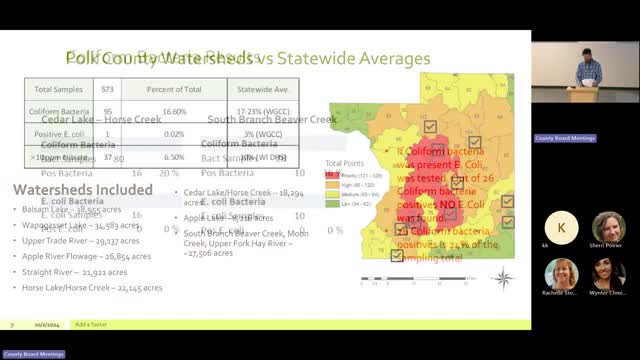County reports groundwater tests show low E. Coli and nitrate levels
October 02, 2024 | Polk County, Wisconsin
This article was created by AI summarizing key points discussed. AI makes mistakes, so for full details and context, please refer to the video of the full meeting. Please report any errors so we can fix them. Report an error »

The Environmental Services Meeting held on October 2, 2024, in Polk County, Wisconsin, focused on groundwater quality and water testing results. The meeting began with a presentation on the latest findings from the county's water testing program, which has conducted a total of 573 samples. The results indicated a concerning increase in coliform bacteria, with more positive tests reported this year, although the county remains below the statewide average for both coliform bacteria and nitrates.
The presentation highlighted that only one sample tested positive for E. Coli, significantly lower than the statewide average of 3%. This suggests that, overall, groundwater quality in Polk County is satisfactory for most residents. The discussion included a breakdown of chloride levels, which are not a public health concern but can affect water taste. The data showed that 69% of samples had chloride levels below 10 parts per million, with only a small percentage exceeding 50 parts per million.
An important aspect of the meeting was the announcement of an upcoming webinar scheduled for October 10 at 6:30 PM, where residents can engage in discussions about groundwater systems and their well tests. Participants in the water testing program received informational packets detailing their results, and the county emphasized the importance of using the water and environmental analysis lab in Stevens Point for accurate testing.
The meeting also addressed the protocol for handling positive test results, particularly regarding E. Coli. Officials explained that immediate outreach is conducted to affected individuals, advising them on necessary precautions and further testing. The conversation revealed that many issues stem from inadequate well construction, such as broken caps or insufficient elevation above grade, which can allow surface water contamination.
In conclusion, the meeting underscored the county's commitment to monitoring and improving groundwater quality while providing residents with the resources and information needed to ensure safe drinking water. The next steps include continued testing and community engagement through the upcoming webinar.
The presentation highlighted that only one sample tested positive for E. Coli, significantly lower than the statewide average of 3%. This suggests that, overall, groundwater quality in Polk County is satisfactory for most residents. The discussion included a breakdown of chloride levels, which are not a public health concern but can affect water taste. The data showed that 69% of samples had chloride levels below 10 parts per million, with only a small percentage exceeding 50 parts per million.
An important aspect of the meeting was the announcement of an upcoming webinar scheduled for October 10 at 6:30 PM, where residents can engage in discussions about groundwater systems and their well tests. Participants in the water testing program received informational packets detailing their results, and the county emphasized the importance of using the water and environmental analysis lab in Stevens Point for accurate testing.
The meeting also addressed the protocol for handling positive test results, particularly regarding E. Coli. Officials explained that immediate outreach is conducted to affected individuals, advising them on necessary precautions and further testing. The conversation revealed that many issues stem from inadequate well construction, such as broken caps or insufficient elevation above grade, which can allow surface water contamination.
In conclusion, the meeting underscored the county's commitment to monitoring and improving groundwater quality while providing residents with the resources and information needed to ensure safe drinking water. The next steps include continued testing and community engagement through the upcoming webinar.
View full meeting
This article is based on a recent meeting—watch the full video and explore the complete transcript for deeper insights into the discussion.
View full meeting
